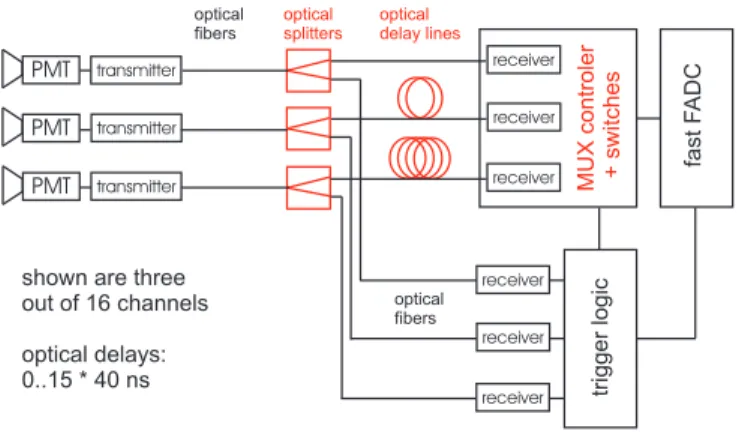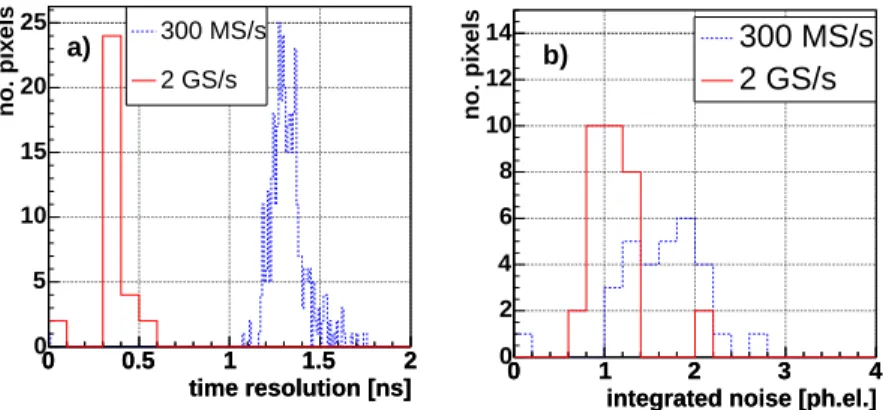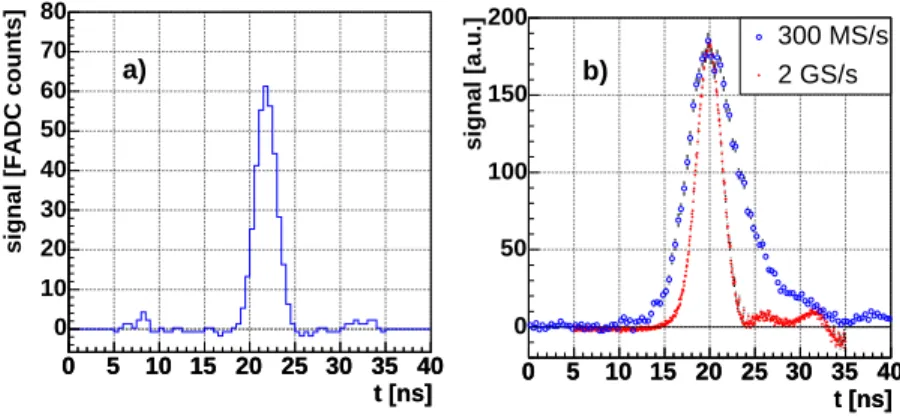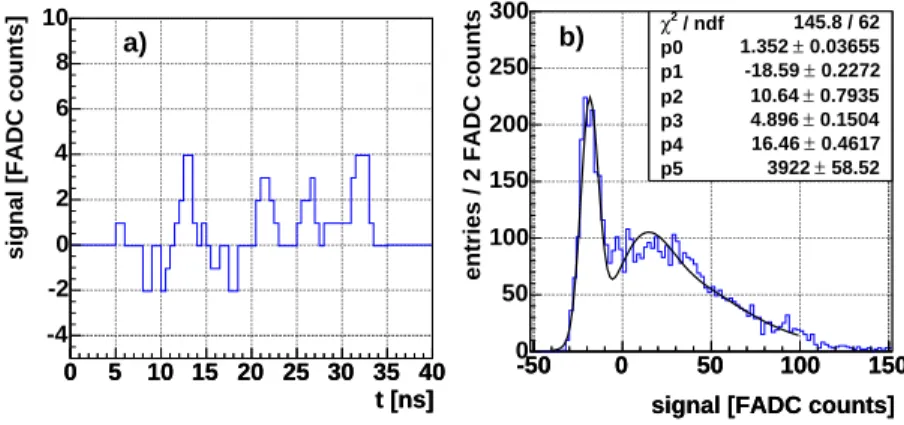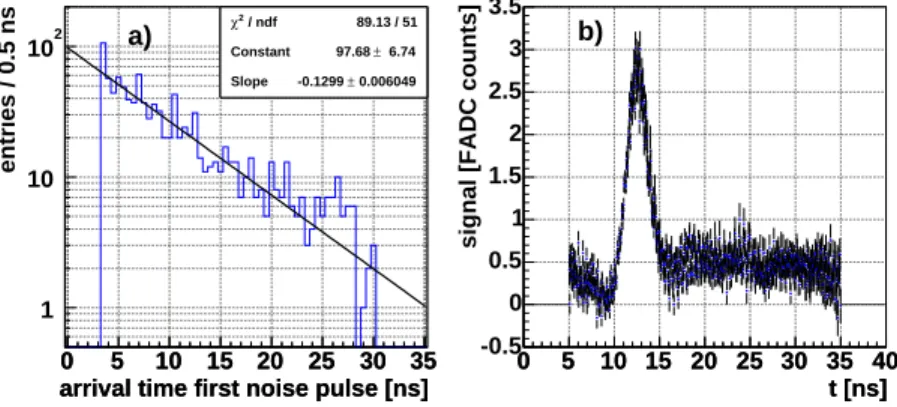Tests of a Prototype Multiplexed Fiber-Optic Ultra-fast FADC Data Acquisition System for the MAGIC
Telescope
Hendrik Bartko, Florian Goebel, Razmick Mirzoyan, Wendelin Pimpl, Masahiro Teshima
Max Planck Institute for Physics, F¨ohringer Ring 6, 80805
Ground-based Atmospheric Air Cherenkov Telescopes (ACTs) are successfully used to observe very high energy (VHE) gamma rays from celestial objects. The light of the night sky (LONS) is a strong background for these telescopes. The gamma ray pulses being very short, an ultra-fast read-out of an ACT can minimize the influence of the LONS. This allows one to lower the so-called tail cuts of the shower image and the analysis energy threshold. It could also help to suppress other unwanted back- grounds.
Fast ’flash’ analog-to-digital converters (FADCs) with GSamples/s are available commercially; they are, however, very expensive and power consuming. Here we present a novel technique of Fiber-Optic Multiplexing which uses a single 2 GSam- ples/s FADC to digitize 16 read-out channels consecutively. The analog signals are delayed by using optical fibers. The multiplexed (MUX) FADC read-out reduces the cost by about 85% compared to using one ultra-fast FADC per read-out channel.
Two prototype multiplexers, each digitizing data from 16 channels, were built and tested. The new system will be implemented for the read-out of the 17 m diameter MAGIC telescope camera.
1 Introduction
MAGIC is the world-wide largest Imaging Air Cherenkov Telescope (IACT). It aims at studying gamma ray emission from the high energy phenomena and the violent physics processes in the universe, at the lowest energy threshold among existing IACTs [2, 3].
The camera of the MAGIC Telescope consists of 576 photomultiplier tubes (PMT), which deliver via an analog-optical link about 2 ns FWHM fast pulses to the experi- mental control house. The currently used read-out system [1] is relatively slow (300 MSamples/s). To record the pulse shape in detail, an artificial pulse stretching to about 6.5 ns FWHM is used. This causes more light of the night sky to be integrated, which acts as additional noise. Thus the analysis energy threshold of the telescope is limited, and the selection efficiency of the gamma signal from different backgrounds is reduced.
For the fast Cherenkov pulses (2 ns FWHM), a FADC with 2 GSamples/s can provide at least four sampling points. This permits a reasonable reconstruction of the pulse shape. Monte Carlo (MC) based simulations predict different time structures for gamma and hadron induced shower images as well as for images of single muons.
The timing information is therefore expected to improve the separation of gamma events from the background events [4].
Such an ultra-fast read-out can strongly improve the performance of MAGIC. The improved sensitivity and the lower analysis energy threshold will considerably extend the observation range of MAGIC, and allow one to search for very weak sources at high redshifts.
A few FADC products with2GSamples/s and a bandwidth 500MHz are available commercially; they are, however, very expensive and power-consuming. To reduce the cost of an ultra-fast read-out system, a 2 GSamples/s read-out system has been developed at the Max-Planck-Institut f¨ur Physik in Munich. It uses the novel technique of Fiber-Optic Multiplexing [12], an approach possible because the signal duration (few ns) and the trigger frequency (typically1 kHz) result in a very low duty cycle for the digitizer. The new technique uses a single FADC of 700 MHz bandwidth and of 2 GSamples/s to digitize 16 read-out channels consecutively. The analog signals are delayed by using optical fibers. A trigger signal is generated using a fraction of the light, which is branched off by fiber-optic light splitters before the delay fibers. With the Fiber-Optic Multiplexing a cost reduction of about 85% is achieved compared to using one FADC per read-out channel.
The suggested 2 GSamples/s multiplexed (MUX) FADC system will have a 10 bit amplitude resolution. For large signals the arrival time of the Cherenkov pulse can be determined with a resolution better than 200 ps. The system is relatively simple and reliable. All optical components and the FADCs are commercially available, while the multiplexer electronics has been developed at the MPI in Munich. Two prototype multiplexers, for 32 channels in total, were built and tested in-situ as read-out of the MAGIC telescope in La Palma in August 2004.
2 The Ultra-fast Fiber-Optic MUX-FADC Data Acqui- sition System
The basic idea of the MUX-FADC system is to “pack” the signals of many channels into a single FADC channel. The block diagram of the MUX-FADC system is shown in figure 1. The ultrafast fiber-optic multiplexer consists of three main components:
fiber-optic delays and splitters, multiplexer electronics (fast switches and controllers) and ultra-fast FADCs.
After the analog optical link between the MAGIC PMT camera and the counting
fastFADC PMT
PMT PMT
receiver receiver
receiver transmitter
transmitter transmitter
receiver receiver
MUXcontroler +switchestriggerlogic
receiver optical
splitters optical delay lines
optical fibers optical
fibers
shown are three out of 16 channels optical delays:
0..15 * 40 ns
Figure 1:Schematic diagram of the multiplexed fiber-optic ultra-fast FADC read-out. See text.
house the optical signals are split into two parts. One part of the split signal is used as an input to the trigger logic. The other part is used for FADC measurements after passing through a fiber-optic delay line of a channel-specific length.
The multiplexer electronics allows only the signal of one channel at a time to pass through and be digitized by the FADC. The other channels are attenuated by more than 60 dB for the fast MAGIC signals. In this way one “packs” signals from different channels in a time sequence which can be digitized by a single FADC channel.
Because of the finite rise and fall times of the gate signals for the switches and because of some pick-up noise from the switch one has to allow for some switching time between the digitization of two consecutive channels. The gating time for each channel was set to 40 ns, of which the first and last 5 ns are affected by the switching process. For the use in MAGIC a16!1multiplexing ratio was chosen. 16 channels are read out by a single ultra-fast FADC channel. The technological part of the fiber- optic multiplexer is described in detail in reference [12].
3 Prototype Test in the MAGIC Telescope on La Palma
Two prototype MUX-FADC read-out modules for 32 channels were tested as a read- out of the MAGIC telescope during two weeks in August/September 2004. They were integrated into the MAGIC read-out system allowing the simultaneous data taking with the current 300 MSamples/s read-out and the MUX-FADC prototype read-out.
The common MAGIC trigger was used to trigger the MUX boards as well as the fast FADCs. In order to acquire only events where the shower image is located in the 32 MUX-FADC channels, only these channels were enabled in the MAGIC trigger
system.
3.1 Data Analysis
For the signal reconstruction a fixed number of FADC samples is integrated. The integration interval was chosen to be 4 FADC samples (corresponding to 4*3.33 ns
= 13.33 ns) for the current MAGIC FADCs. For the MUX-FADCs a window size of 10 FADC samples is chosen, corresponding to a 5 ns integration window [10, 12].
The arrival time was calculated as the first moment of the FADC samples used for the charge integration.
The calibration system of the MAGIC telescope consists of intensity controlled fast LED light pulsers of different colors and intensities that illuminate the MAGIC camera homogeneously. The calibration procedure is described in [7]. The event to event variation of the timing difference between two read-out channels for the LED pulser provides a measure of the timing accuracy. Figure 2a shows the distributions of the determined timing resolution of the current 300 MSamples/s FADCs together with the timing resolution of the MUX-FADCs. The timing accuracy strongly depends on the signal to noise ratio and the width of the input light pulse. The MUX-FADCs yield a better timing resolution by more than a factor of three compared to the current FADC system using the simple and stable timing extraction algorithm.
time resolution [ns]
0 0.5 1 1.5 2
time resolution [ns]
0 0.5 1 1.5 2
no. pixels
0 5 10 15 20
25 300 MS/s
2 GS/s a)
integrated noise [ph.el.]
0 1 2 3 4
integrated noise [ph.el.]
0 1 2 3 4
no. pixels
0 2 4 6 8 10 12
14 300 MS/s
2 GS/s b)
Figure 2:a) Distributions of the timing resolution for the current 300 MSamples/s FADC read- out and the MUX-FADC read-out. The MUX-FADC system yields an improvement in the timing resolution by more than a factor of three. b) Distributions of the integrated noise per pixel in the signal reconstruction window after calibration into photo electrons for the current 300
MSamples/s FADC read-out and using the MUX-FADC read-out.
In figure 3a one can see the pulse shape in a single pixel for a typical cosmics
event. By overlaying the recorded FADC samples of many cosmics events after ad- justing to the same arrival time, the average reconstructed pulse shapes can be cal- culated. Figure 3b shows the comparison of the average reconstructed pulse shapes recorded with the current 300 MSamples/s MAGIC FADCs, including the 6ns pulse stretching, and with the MUX-FADCs. The average reconstructed pulse shape for cosmics events has a FWHM of about 6.3 ns for the current FADC system and a FWHM of about 3.2 ns for the MUX-FADC system.
t [ns]
0 5 10 15 20 25 30 35 40 t [ns]
0 5 10 15 20 25 30 35 40
signal [FADC counts]
0 10 20 30 40 50 60 70 80
a)
t [ns]
0 5 10 15 20 25 30 35 40 t [ns]
0 5 10 15 20 25 30 35 40
signal [a.u.]
0 50 100 150
200 300 MS/s
2 GS/s b)
Figure 3:a) Pulse shape in a single pixel for a typical cosmics event after pedestal subtraction.
b) Comparison between the mean reconstructed pulse shapes recorded with the current MAGIC FADCs (open circles) and with the MUX-FADCs (full points).
In the data recorded by an IACT, the electronics noise together with the LONS fluctuations is superimposed on the Cherenkov signal from air-showers. The noise from the LONS can be simulated as the superposition of the detector response to single photo electrons, arriving at a given rate but randomly distributed in time.
Figure 2b shows the distributions of the integrated noise (integrated pedestal RMS after calibration in photo electrons) per pixel for the current FADC system and for the MUX-FADC system. The shorter integration time used for the pulse recon- struction with the MUX-FADC system yields a reduction of the effective integrated noise by about 40%.
Using the new MUX-FADC system the noise contributions due to the LONS may even be resolved into individual pulses. Figure 4a shows a typical example for the signals in a pedestal event (random triggers). The pedestal does not vary in an uncorrelated way. Instead most of the pedestal variations are due to peaks on the signal baseline.
The rate of the peaks was studied to verify whether it is compatible with the rate of LONS photo electrons [12]. Figure 5a shows the arrival time distribution of the
t [ns]
0 5 10 15 20 25 30 35 40 t [ns]
0 5 10 15 20 25 30 35 40
signal [FADC counts]
-4 -2 0 2 4 6 8 10
a)
signal [FADC counts]
-50 0 50 100 150
/ ndf
χ2 145.8 / 62
p0 1.352 ± 0.03655 p1 -18.59 ± 0.2272 p2 10.64 ± 0.7935 p3 4.896 ± 0.1504 p4 16.46 ± 0.4617 p5 3922 ± 58.52
signal [FADC counts]
-50 0 50 100 150
entries / 2 FADC counts
0 50 100 150 200 250
300 χ2 / ndf 145.8 / 62
p0 1.352 ± 0.03655 p1 -18.59 ± 0.2272 p2 10.64 ± 0.7935 p3 4.896 ± 0.1504 p4 16.46 ± 0.4617 p5 3922 ± 58.52
b)
Figure 4:a) Time structure in a typical pedestal event. The peaks on the baseline might be due to single photo electrons from the light of the night sky. b) Reconstructed single photo electron
spectrum of a simulated pedestal run. The leftmost peak is the pedestal.
first noise peak. The distribution can be fit by an exponential function with a rate
r=(0:130:01)ns
1. This corresponds to an integrated LONS charge of about 1.3 photo electrons per 10 ns integration window, which is in good agreement with the expected LONS rate.
Figure 5b shows the pulse shape of the selected noise peak averaged over many events. It has a FWHM of about 2.6 ns. This corresponds to the response of the instrument to aÆ-function input pulse (single LONS photo electrons have no internal time structure).
3.2 MC Simulations
The response of the MAGIC telescope to gamma ray showers and to background was simulated in detail [8]. Both the currently used 300 MSamples/s readout chain and the ultra-fast digitization were simulated. For both MC simulations the same LONS conditions are assumed as well as the same electronics noise level. The input light pulse has a FWHM of 1 ns as expected for gamma-ray induced showers.
Contrary to the simple signal and arrival time extraction algorithms used above, a dedicated numerical fit to the FADC samples using a known pulse shape [9, 10]
has been applied to illustrate the theoretically achievable resolution. Figure 4b shows the reconstructed single photo electron spectrum of a simulated pedestal run. The leftmost peak is the pedestal. The MUX-FADC system improves the timing resolution by about a factor of 2. Also the charge resolution improves by a factor of two. For a more detailed description see [12].
arrival time first noise pulse [ns]
0 5 10 15 20 25 30 35
/ ndf
χ2 89.13 / 51
Constant 97.68 ± 6.74 Slope -0.1299 ± 0.006049
arrival time first noise pulse [ns]
0 5 10 15 20 25 30 35
entries / 0.5 ns
1 10 102
/ ndf
χ2 89.13 / 51
Constant 97.68 ± 6.74 Slope -0.1299 ± 0.006049
a)
t [ns]
0 5 10 15 20 25 30 35 40 t [ns]
0 5 10 15 20 25 30 35 40
signal [FADC counts]
-0.5 0 0.5 1 1.5 2 2.5 3 3.5
b)
Figure 5:a) Arrival time distribution of the first noise peak on the pedestal baseline. The peaks are arriving randomly in time with a rate of(0:130:01)ns 1. b) Average reconstructed
shape of the LONS noise peaks. The FWHM is about 2.6 ns.
4 Discussion
The ultra-fast fiber-optic multiplexed FADC prototype read-out system was success- fully tested during normal observations of the MAGIC telescope in La Palma. The ultra-fast FADC read-out has grown to a mature technology which is ready for the use as a standard read-out system for the MAGIC telescope and other high-speed data acquisition applications.
The MUX-FADC read-out reduces the costs by about 85% compared to using one ultra-fast FADC per read-out channel. Also the power consumption of the read-out system is greatly reduced.
The ultra-fast MUX-FADC system allows to use a shorter integration window for the Cherenkov pulses. The reduction of the pulse integration window from 13.33 ns (4 samples with 3.33 ns per sample) for the current MAGIC FADC system to 5 ns (10 samples with 0.5 ns per sample) for the MUX-FADC system corresponds to a reduction of the integrated LONS charge by a factor of about 2.7. Consequently, the RMS noise of the LONS is reduced by about 40%.
A reduction in the noise RMS translates into lower image cleaning levels [12], a larger part of the shower image (a shower image of a higher signal to noise ratio) can be used to calculate Hillas parameters [11]. This is especially important for low energy events where the signals of only a few pixels are above the image cleaning levels. This will allow the reduction of the analysis energy threshold of the MAGIC telescope.
The ultra-fast FADC system also provides an improved resolution of the timing
structure of the shower images. As indicated by MC simulations [4] gamma showers, cosmic ray showers and the so called single muon events have different timing struc- tures. Thus the ultra-fast FADC read-out can enhance the separation power of gamma showers from backgrounds.
After the successful prototype test of the ultra-fast MUX-FADC read-out system it is ready to be installed as a future read-out of the MAGIC telescope.
Acknowledgments
The authors thank R. Maier and T. Dettlaf from the electronics workshop of MPI for the layout, design and production of the MUX-FADC electronics. We also acknowl- edge the very good collaboration with the companies Acqiris and Sachsenkabel.
References
[1] F. Goebel et al. (MAGIC Collab.), Proc. of the 28th ICRC, Tokyo, 2003.
[2] C. Baixeras et al. (MAGIC Collab.), Nucl. Instrum. Meth. A518 (2004) 188.
[3] Cortina, J. et al. (MAGIC Collab.), Proc. of the 29th ICRC, Pune, India , to be published, astro-ph/0508274.
[4] R. Mirzoyan, these proceedings pp. ??-??.
[5] R. Mirzoyan et al., IEEE Trans. Nucl. Sci. 49 (2002) 2473 .
[6] R. Mirzoyan, J. Cortina and E. Lorenz, Proc. of the 27th ICRC, Hamburg, Germany, 2001.
[7] Gaug, M. et al. (MAGIC Collab.), Proc. of the 29th ICRC, Pune, India, to be published, astro-ph/0508274.
[8] Majumdar, P. et al. (MAGIC Collab.), Proc. of the 29th ICRC, Pune, India, to be published, astro-ph/0508274.
[9] W. E. Cleland and E. G. Stern, Nucl. Instrum. Meth. A338 (1994) 467.
[10] H. Bartko et al. (MAGIC Collab.), these proceedings pp. ??-??, astro- ph/0506459.
[11] A. M. Hillas, Proc. of the 19th ICRC, La Jolla, USA, 1985.
[12] H. Bartko et al., NIM A548 (2005) 464-486.
